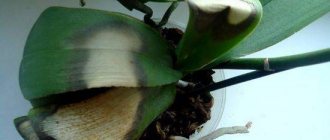Reproduction of orchids by children
This method is most relevant for the most common orchids of the phalaenopsis species.
It is these plants that reproduce very readily even without additional intervention from the grower. Reproduction of orchids at home with the help of children can be provoked by hormonal pastes containing cytokinins. However, children often appear in the roots and on the trunk of the plant itself. This paste contains phytohormones - cytokinins, which accelerate the plant's metabolism and enhance the growth of new shoots and buds. However, it should only be used on healthy and mature plants.
The natural appearance of babies in orchids is possible immediately after flowering. The upper or middle bud on the peduncle awakens and produces either new growth or a new shoot. Read on to learn how to propagate orchids using paste.
Baby on a peduncle
In order to get a baby on a peduncle, you can use cytokinin paste. The action plan will be as follows:
- Using a sterile instrument, it is necessary to bend back the scales covering the dormant bud.
- Use a heated needle or clean toothpick to scratch the plant tissue next to it.
- Apply the paste to the dormant bud in a volume the size of a pinhead.
- The awakening of the kidney can be observed on days 7-10.
Propagation using orchid paste can result in the formation of 2-3 new shoots from one bud. Such mutations are very harmful to the aesthetic appearance and lead to severe stress on the mother plant. This can happen both due to an overdose of hormonal paste, and due to genetic pathologies in development. It is difficult to say how strong or weak the baby will be, but, according to numerous reviews from flower growers, the offspring after cytokinin paste are an order of magnitude weaker, and the flowering is not as lush as that of the mother.
Another important point when propagating orchids by children is the need for proper rooting of the child. Quite often, young growths are in no hurry to build up the root system, but they push out new leaves one after another and may even bloom. This situation has a negative impact on the mother; she may not have enough strength to feed the baby.
A good way to quickly grow roots in young plants is to create a cushion of moss or so-called planting in a pot directly on the mother’s peduncle. For this we need:
- A small pot with a diameter of 2.5 cm or a cut plastic bottle of 0.5 liters.
- Scissors.
- Scotch.
- Sphagnum moss.
- Pin.
At the bottom of the pot we make a hole for the diameter of the peduncle. Using scissors, we cut the pot vertically down to the hole and wrap the pot around the peduncle so that the baby is ¾ of the way up to the pot. Secure the container from below with a clothespin. We glue the walls of the pot together with tape and put sphagnum moss inside, after moistening it with water and a rooting agent. A good drug for this is Kornevin - it is accessible and inexpensive.
This method adapts young plants well to independent life, and the undoubted advantage is that the orchid immediately learns to feed on roots, which reduces stress during transplantation. Among other things, flower growers note a positive point in the fact that the roots immediately grow inside the pot and the transplant will be less traumatic.
Root baby
Basal children, or as they are also called, basal, can appear in monopodial orchid species. Most often they begin to grow in phalaenopsis, but it is impossible to induce an orchid to this type of reproduction. As a rule, a basal baby appears when the mother plant is in danger and the plant does not want to interrupt its life cycle.
Experienced gardeners categorically do not recommend smearing the trunk of healthy phalaenopsis with cytokinin paste - this method can be detrimental to the plant.
Problems and difficulties
Advice.
If the orchid is withering away and no pests are visible, dip the pot with it in soda.
Sometimes a gardener, after planting a Vietnamese orchid bulb, notices pests in the soil. She is a tasty prey for thrips, mites and roundworms. More often this happens when it gives roots and stems appear from the adventitious bud.
Without which he can get sick and die.
In order to grow a healthy plant from a Vietnamese bulb, you need to know the rules for planting it and observe the necessary conditions for its growth. Only then will she delight all household members with beautiful flowers.
The Vietnamese orchid is called Paphiopedilum, and popularly - Venus's slipper
. It received such an unusual name because its lower petal forms a pocket, similar to the toe of a shoe.
They are presented in two types: air and ground. The first grow their roots into tree trunks, and their stems and flowers hang in the air. The latter grow on the ground in places where humus and debris accumulate.
Paphiopedilums, which tourists most often bring to Russia, also differ in the color and shape of the flowers, and the size of the inflorescences.
Vietnamese
is quite large
, the diameter of which can reach 10 cm. Their color can be very diverse.
Mostly coffee-lilac
.
Vietnamese.
Siamese
On its peduncle there is only one flower, which has a lilac-green tint.
. The lower petal of the inflorescence is brown.
Siamese.
Beautiful
The flowers are characterized by a greenish-orange color and a diameter of up to 15 cm
. The petals have dark veins and large black blotches, and the lowest one is bright orange with dark green stripes.
Beautiful.
Plain
The orchid received this name due to its monochrome color. Flower petals are white, sometimes with cream and purple hues, as well as small purple dots
. The lower petal is elongated and has a curved edge. The core is bright yellow.
Plain.
Appleton
Features large flowers
, having greenish-purple cups. The sepals are covered with purple and dark veins. The petals have large brown spots.
Appleton.
Bearded
This species has large purple-green flowers up to 10 cm in diameter
. The upper sepals are pierced by dark purple stripes, and the lateral petals are covered with dark bristles and warts along the edges. They all have a white border.
Only the lower lip is distinguished by its burgundy color. Light green leaves are sprinkled with dark spots.
Bearded.
Elena
The general color of the flower is glossy, yellow-brown. It is distinguished by the unusual texture of the petals, which are covered with wax.
. The lower petal has a smooth surface and an orange-brown color.
When buying an orchid bulb, you need to carefully examine it, without trusting the seller. To do this, you need to follow the following recommendations:
- It is better to take a medium-sized bulb, since a small one takes longer to grow, and a large one will die faster;
- it is desirable that its shell has a greenish tint against a brown background;
- The bulb that has buds or has a small sprout will grow faster.
A bulb that combines the above symptoms will not keep you waiting long for positive results.
Types with names
Most often, terrestrial types of orchids are brought from Vietnam, such as:
- Beautiful - during flowering, its buds reach 6-8 cm in diameter, green-orange petals are decorated with dark dots and lines.
- Siamese - on one peduncle there is only one greenish-pink flower.
- Vietnamese - has unusual lower flowers of various colors, the lower petal of which resembles a shoe.
- Single-flowered is the earliest type of orchid with a short peduncle, on which 1-2 relatively small (maximum 7 cm in diameter) buds are formed.
- Appleton - characterized by a large (about 10 cm in diameter) bud, which combines brown and purple colors.
- Bearded - distinguished by burgundy-colored buds with a light border along the edges.
- Elena - this species blooms for 3 months, and its single yellow flowers seem to be covered with a waxy coating.
Despite the differences in the number of flowers, their color and flowering period, all these species require the same care.
And this is what this flower looks like in the photo.
Care
Even if you plant an orchid bulb correctly, but you do not care for it properly, it will die immediately. It is necessary to strictly fulfill all the requirements for rooting Vietnamese orchid bulbs.
Advice! Remembering that the orchid loves light, it should be placed on the sunny side. The air temperature in the room should be kept at 17-18 degrees at night and 20-25 degrees during the day, and the humidity should be about 50-70%.
Watering and temperature
It should be remembered that there is no need to water the plant immediately after planting, as it will rot. Only the roots and sprouts of the plant need moisture, and the bulb has a supply of water for a month.
Watering begins when the first roots and shoots appear. This usually happens 30 days from the date of planting.
After planting, the pots should be removed to a bright place. But the sun should not dry out the bulb, and condensation should not form in the pot. The flower needs to create the following conditions:
- air temperature – +18 degrees and above;
- air humidity is within 50 – 70%.
Care begins immediately after the roots appear. At this time, the plant is watered for the first time. After about a month, the bulb that has taken root is transplanted. During this time, she will have time to accumulate the substances necessary for growth and development.
Caring for an orchid brought from Vietnam includes the following steps:
- monthly fertilizing with mineral fertilizers purchased in the store;
- Watering is carried out only when the substrate dries. In hot summers, watering is carried out daily, and in winter – once every 2 weeks. Watering the plant is done only in the morning;
- From time to time you need to shower the flowers.
As you can see, the care work is quite simple, especially if you know all the intricacies.
Reader Questions
Is it possible to grow a bulba from a Vietnamese orchid at home?
It is impossible to grow a bulba from a Vietnamese orchid at home . Since this requires special conditions, and the old onion dries out over time and only a sprout remains in its place.
The bulb dies after it has sprouted.
How to properly store a purchased bulb before planting?
The bulb can be safely stored in the bag in which it was packaged when sold. But if the possibility of planting it appears no earlier than in a week, you need to make holes in the bag so that the bulb does not lock.
Are there any restrictions on export from Vietnam?
Tourists transporting Vietnamese orchid bulbs will freely pass customs control, regardless of their quantity. Difficulties can only arise when transporting an orchid in a pot.
Photo
Next, you can see a photo of what the seeds look like and what grew from them:
Care
After a few weeks or months, changes begin to occur in the crops. Green balls appear on them, then the first leaves. After two or three leaves appear, roots begin to appear. Only after a year can the seedlings be transplanted into a pot. To fill the pot, a suitable substrate of moss, fern roots and pine bark is suitable.
The soil should be as fine as possible. The sprouts are removed from the flask as carefully as possible with tongs, washed in water and transplanted into a substrate, which is first poured with boiling water for 30 minutes. Plants need light and high humidity all the time.
Propagation of orchids by cuttings
In order to propagate an orchid by cuttings, you need to know for which species this method is suitable. Oddly enough, both sympodial and monopodial species can be propagated by cuttings. In the first case, cuttings will be carried out with a pseudobulb, and in the second - with peduncles.
The best results of this type of propagation are produced by dendrobiums and phalaenopsis. However, there are also negative experiences, since the result depends on many factors: environment, lighting, and most importantly, the genetic characteristics of the orchid. Experienced gardeners also do not recommend using cymbidiums, cattleyas and other more expensive species for this.
So what should you do to propagate from cuttings?
- We will need a peduncle or pseudobulb. The peduncle can be cut off after it begins to dry out, and the pseudobulb can be taken from any faded dendrobium.
- We will need a mixture of fine bark and sphagnum moss.
- Sections of peduncles can be dried, sections of pseudobulbs can be treated with phytosporin or filled with paraffin.
- We place the prepared substrate in a greenhouse and place the cuttings there.
- As the substrate dries, it should be moistened with a spray bottle. The temperature should be maintained at 23-25 degrees, there should also be diffused light and regular ventilation.
The first results can be seen within 1-2 weeks. Dormant buds may awaken on the peduncles of phalaenopsis, and new shoots may appear on the pseudobulbs of dendrobium, which will eventually become babies.
Reviews
Reviews from people who have encountered these flowers:
The bright colors of its petals are pleasing to the eye. Even the most whimsical bouquets pale next to these amazing creatures in pots. The complex inflorescence will not leave anyone indifferent. Despite the capriciousness of this species, you should not refuse to purchase at least one bulb. Over time, such a purchase will meet all your expectations.
An orchid is a worthy and appropriate gift for all occasions. Be it a birthday, wedding anniversary or a present for a work colleague. This flower will amaze anyone with its effectiveness. It has the energy of inspiration, reveals a person’s hidden resources, giving rise to new ideas and pushing him to take decisive action. An orchid is a symbol of happiness, and this does not require much - just proper care for it.
This fascinating process of growing exotic crops is addictive. It all starts with one bulb brought from Vietnam. Of course, even experienced flower growers fail, and some beauties die for various reasons. But if you build an algorithm for care: diffused light, avoid drafts and overheating, do not overdry or flood the roots of flowers, replant on time and correctly, do not water with cold chlorinated water, then success will be ensured and the work will be justified.
Growing an orchid is a risk. But this risk is justified; the main thing is to plant the orchid bulb correctly. By applying a minimum of care to this sensitive, but truly gorgeous flower, you can get the maximum result of your labors - the Lady's Slipper will reveal itself in all its diversity and color.
Landing
The bulb should be planted as quickly as possible so that it does not dry out in the air without soil. So that it sprouts:
- She is planted according to certain rules;
- And they provide proper, comprehensive care.
Substrate
The substrate can be:
- Purchase from a specialized store;
- But you can compose it yourself.
But such an onion cannot be planted in soil from the garden; it will suffocate and die in it without producing the expected sprout. Components that are necessary when preparing the soil:
- Pine bark without resinous deposits - 5 parts;
- Charcoal – 1 part;
- Peat – 1 part;
- Perlite – 1 part.
You can also add fern roots and sphagnum moss to this mixture in any quantity, but not exceeding 1 part. The substrate is mixed well and disinfected. To do this, place it in the freezer of the refrigerator for a day.
IMPORTANT! If you decide to prepare the soil with your own hands, you need to remember to sterilize it.
Necessary equipment
In order to plant a bulb, in addition to the substrate, you must have:
- Large stones that will provide stability and serve as drainage;
- Small plastic pot;
- Wooden sticks to hold the bulb steady until it takes root.
Technology
Planting a Vietnamese orchid is carried out as follows:
- Stones are placed at the bottom;
- The prepared substrate is poured on top;
- Soak the soil well with water and allow it to drain completely;
- The bulb is laid on the ground with its butt down, deepening it by 1 cm. At the same time, so that it does not fall, it is secured with sticks. You can use toothpicks or skewers.
Important! The container where the bulb will be planted must have drainage holes to drain water.
Further care
From the moment of planting to the flowering of such an orchid, a fairly long period of time passes, 5-8 years, and everything depends on properly organized care.
For further flowering, the orchid requires proper care.
These flowers are very whimsical and require a careful approach to their content.
Conditions of detention
One of the main conditions for maintaining a plant is maintaining the required temperature in the room where the flower is cultivated. It should be between 18-25 degrees Celsius. A change in temperature in any direction leads to the death of bulbous orchids. It happens:
- Or from hypothermia of the bulb;
- Or its overheating.
For successful growth and flowering, the plant requires a temperature difference between day and night of 4-5 degrees.
Lighting
Planted bulbs are placed where there is a lot of scattered sunlight. You cannot place it in the sun, as direct rays will dry out the bulb and it will die.
During further care, to determine how much lighting it needs, you need to look at its leaves.
If they are bright green, this species prefers lots of indirect sunlight on east and west windows.
If there are various natural inclusions on the leaves, then northern windows are suitable for this specimen.
IMPORTANT! If the apartment has only south-facing windows, then this is not a problem. For the summer period, from the beginning of May, the flower is placed deep in the apartment, and in September it is returned to the windowsill.
Watering and fertilizing
It is not recommended to water the bulb immediately after planting, since the soil is already thoroughly moistened when planting. Excessive watering can lead to the death of the plant.
You also need to remember that the bulb has the necessary supply of substances it needs to survive the rest period, the main thing is not to prolong it. Therefore, the first watering is done only at the moment when the bulb comes out of dormancy. The florist will be informed about this by the nose of the leaf appearing from the top of the bulb.
When planting a bulb, you should not immediately water the flower.
Fertilizing begins only from the moment the bulb germinates and once a month. With the beginning of flowering, fertilizing is increased and carried out twice a month. In winter or after the end of the flowering period, the orchid bulb enters a dormant state and no longer needs feeding.
Important! Fertilizing is carried out only with specialized fertilizer and only on wet roots. This is done in order not to burn the root system of the orchid plant.
Plant care
When you hear the words “grow an orchid at home,” many people roll their eyes, believing that it is very difficult and energy-consuming. However, this is not true; caring for these bulbous plants is quite simple. Let us dwell on the key points of caring for and growing Vietnamese orchids in more detail. After planting, the plant is not watered until its bulb gives the first strong roots. After the first watering, you need to wait another month to replant the plant. It is believed that this time is enough for the bulb to be saturated with all the elements necessary for growth.
Vietnamese orchids are sun-loving. The air in the room where they are located should be warm and humid. A window sill on the south side of the house would be optimal, however, you need to be careful with direct sunlight - their light should not fall on the orchid. Well, in autumn and winter you will have to take care of sources of artificial lighting - after all, the Asian beauty needs light all year round.
Flowers will appreciate the diffused rays of the sun much more than direct sunlight. This rule does not apply to either the morning or evening rays of the sun; their flowers tolerate them perfectly. It’s a good idea to shade slightly when the plant has already formed. During the growth phase, the orchid needs long daylight hours and short (5-6 hours) nights. If you planted the bulb in winter, you can “revive” it by using intense artificial light.
As for the temperature regime, you need constant, even heat without changes. It is better if the temperature does not fall below +18 and does not rise above +25 degrees. Temperature jumps, both towards cold and towards heat, are very harmful for young, not yet formed plants. As soon as the plant “starts to grow,” it needs to be watered frequently, but superficially, avoiding flooding. As soon as the soil is dry, watering is carried out, preferably in the morning.
To learn how to grow an orchid from Vietnamese bulbs, watch the video below.
Description
Orchid is an asparagus-flowering plant of the orchid family (lat. Orchidaceae). The name of the flower was given by the ancient Greek philosopher Theophrastus based on the shape of the bulb; from the Greek “orhis” means “testicle”. There are many up to 30 thousand species of this ancient family, which appeared in the Late Cretaceous era. These plants are mainly perennial herbs, less often shrubs and woody vines.
The sizes of paphiopedilums, depending on the species, range from several centimeters to several meters. The shape of the flower is formed according to the following scheme: three sepals and three petals are alternately collected, one or two stamens are fused with the style of the pistil, the stigma of which is located inside under the anther. The most suitable for growing indoors are epiphytic and epilithic.
These flowers grow in two types: ground and aerial. Aerial ones sprout in tree trunks, gracefully falling with leaves and branches. Delicate and fragile like porcelain, they are strikingly different from the bright, juicy ones on the ground. With fleshy, dense stems, they grow into the soil or rock crevices containing organic food.
Among the diversity, it is worth highlighting some varieties of Vietnamese beauties that are hardy for growing indoors. Their differences lie in size, shape and color. Paphiopedilum, or Lady's slipper, is very common among gardeners. Here are the types of Vietnamese orchids:
- Beautiful or beautiful Paphiopedilum (Paphiopedilum venustum) - blooms towards the end of winter with single flowers 15 cm in diameter with green veins and black “freckles”.
- Snow-white Paphiopedilum (Paphiopedilum niveum) - marbled leaves and snow-white flowers with minor inclusions with a diameter of no more than 8 cm, reproduces by tubers.
- Paphiopedilum hirsutissimum - blooms from autumn to spring, the colors are dominated by brown and chocolate shades. Can be grown on a windowsill.
- Paphiopedilum barbatum is one of the artificial hybrids; Blooms in spring with rich burgundy flowers, diluted with white strokes.
- Wonderful Paphiopedilum (Paphiopedilum insigne) – blooms in the autumn and winter months, the petals of the inflorescence are lemon-colored with light green. Bulbous crop, can be planted at home.
- Paphiopedilum armeniacum is a miniature orchid (up to 12 cm) with dazzling yellow flowers.
- Paphiopedilum concolor is another “freckled” species with cream petals, less often pale yellow.
You can plant an orchid from Vietnam by choosing from the varieties described above.
Propagation of orchids by division at home
As already mentioned, the division method is in most cases suitable for sympodial species. Since all pseudobulbs are united by a rhizome, or as it is also called, a rhizome, new growth is just a matter of time
But it is equally important to know that you need to divide plants only in cases where there are too many pseudobulbs and the entire root system no longer fits in the pot.
If you decide to divide your orchid, the question will probably arise as to how to divide it without harming the flower.
To do this, it is important to determine where the rhizome is located and divide according to it. It is extremely important that each division has at least 3 pseudobulbs; the more there are, the faster the orchid adapts after division
Another important feature of sympodial orchids is that a faded pseudobulb will no longer bloom, therefore, when dividing the plant, you need to leave the old ones with new growths; they will initially nourish and support the young plant, and then dry out over time
The separation action plan should be as follows:
- We take the plant out of the pot and use a sterile instrument to separate the pseudobulbs.
- The rhizome cut should be processed. A garden pitch is suitable for this, or you can simply drip it with wax or paraffin.
For many adherents of phalaenopsis who have not encountered other species before, the question of how to plant a dendrobium orchid becomes very relevant. It is worth noting that, although dendrobium is a sympodial species, division is not the only type of its reproduction. Sometimes babies begin to grow on pseudobulbs, which eventually grow roots.
Once the baby has produced new growth, followed by a new pseudobulb, and grown sufficient roots to support its own life, it can be removed by careful cutting with a sterile, sharp instrument.
Orchid replanting
Orchid does not like frequent transplants
She perceives each of them as stress, so this operation must be approached with special attention. Quite frequent replanting of orchids is due to the fact that the substrate in which they live is very short-lived
Made from sphagnum moss, it loses its quality within two years. Substrate with peat - after three. It thickens, its acidity changes. It is already difficult for air to penetrate to the roots in order to supply them with useful substances. In addition, the orchid's root system grows, and after a few years it no longer fits in the old pot. The growth of leaves and flowers slows down.
But sometimes you have to replant an orchid more often. This can happen due to improper care, the presence of pests, or too much watering. In this case, the roots rot, and only transplantation can save the flower. Sometimes problems happen with the substrate. It starts to smell unpleasant. This smell also indicates the need for a transplant.
Flower transplant rules:
The dishes are the same, but with a slightly larger diameter. Disinfect it. Prepare or buy substrate
Carefully remove the plant from the old pot. You need to do this so that the roots are not damaged.
To do this, water the flower well and wait about half an hour until the moisture is absorbed. If even after this the root system is not removed, the pot is sacrificed. The plant is lowered into a bowl or bucket of warm water so that all the old soil comes away from the roots. This usually takes about half an hour. Inspect the root system. If damaged roots are found, cut them off and disinfect the cut site. You can do this by treating it with charcoal. Damaged leaves are also removed. Carefully examine the roots of the orchid to see if any pest has grown on them. They are quite small, so they are not easy to notice. If pests are found, soak the root part in a disinfectant solution or filtered warm water. Remove dried leaves and old dried pseudobulbs. The cut sites are disinfected. Dry the root part for about 8 hours. Immerse the orchid in a new container, at the bottom of which a layer of drainage and substrate is already poured. Carefully add the remaining substrate by shaking and tapping the pot. This will help fill all the voids. Do not compact the substrate too much. As a result of replanting, the root collar should be a centimeter below the edge of the pot, but not in the soil, but above it. There is no need to immerse all aerial roots in the substrate.
Place the pot on the east window, away from direct sunlight. Maintain the room temperature at about 22°C. After transplantation, the orchid is watered after 4 days. Make sure that moisture does not get to the top, where the growing point is located.
Transplantation
Orchids need to be replanted frequently, because the substrate quickly deteriorates, it becomes too dense, and its acidity changes. So flowers growing on sphagnum are replanted every two years, on bark every three years. Sometimes you have to do this more often if pests appear, if the substrate clearly begins to deteriorate (which can be indicated by an unpleasant odor), if improper watering has led to rotting of the roots. The best time for this is spring, when the flower grows most actively.
For transplantation, take new transparent dishes of a slightly larger size and a new substrate. In the same way, stones and a drainage layer are placed on the bottom, then the substrate itself is placed. The flower is watered abundantly so that it can be removed without causing the slightest harm. Sometimes you have to sacrifice an old pot; it is broken or cut if the substrate has become so compacted that even after watering it is not possible to remove the plant. The roots of the plant are placed in warm water to completely free it from the old substrate.
If there are damaged or rotten roots or leaves, they should be carefully cut off and the cut areas should be sprinkled with crushed coal.
The plant is placed in a new pot, the substrate is added, lightly tapping the pot so that it is better distributed. After planting, water the plant; if moisture gets on the growing point, it is better to get it wet. The root collar should be above the substrate, a centimeter below the edge of the pot.
Pot
Planting is done in a container of the required size. The flower must develop in comfortable conditions so that the roots do not become tangled due to lack of space to grow. Basic requirements for a container for an orchid from Vietnam:
- It is better if it is a transparent material such as plastic or glass . This will make it possible to control the condition of the roots. Clay pots are also allowed, but you will have to pay more attention to the root system and watering regime.
- Special containers have holes located slightly higher than half the size of the pot. This is required to ensure air circulation in the soil; excess moisture evaporates and does not lead to rotting of the roots.
- Metal trays should not be used so that the orchids do not die from substances formed during watering.
- The best option for planting this flower would be a small basket made of vines. Watering is not so important to the plant as air circulation. The appearance of such containers allows them to fit into almost any interior.
Orchids from Vietnam: how to grow from bulba
Vietnam is the birthplace of many exotic plants. Instead of traditional souvenirs, tourists often bring bulbs of beautiful flowers from there. Orchids from Vietnam are in particular demand, but not all gardeners know how to grow a capricious crop from bulba in the Russian climate. Before planting orchid bulbs, it is worth studying the recommendations for caring for a heat-loving plant.
Vietnamese orchids.
Special taste - wonderful guests from Vietnam
The orchid is valued all over the world for its original shape and bright color of its flowers; it is not without reason that it is called the “queen of flowers.” It is one of the few ornamental plants that blooms during the winter months.
Delicate flowers bloom when other tuberous crops are resting - this is a beneficial advantage of the plant. In addition to beauty, the culture has another rare property - its flowering lasts up to 30 days.
Some types of orchids bloom for 2-3 months.
The Vietnamese “queen of flowers” naturally grows on the trunks of tall trees, in soil or on limestone in moist, well-lit places.
There are 2 types of orchids growing in the wild - aerial and terrestrial:
- Aerial orchids from Vietnam sink their roots into the bark of trees or rocks, extracting nutritious juices and moisture from them, and their stems with leaves and flowers hang down to the ground.
- Land crops grow in a traditional way: their roots go into the ground, and their stems, leaves and flowers reach towards the sun.
Vietnam has a large selection of orchids. They are sold everywhere: in flower shops, markets, stalls and tents. Tubers of terrestrial plant species are transported to Russia. The bulb of an orchid is called a bulb.
This part of the rhizome is a thickening at the base of the orchid shoot, which contains reserves of water and nutrients.
Bulbs can be transported in luggage, wrapped in dry paper towels or packed in a container with holes.
Requirements for bulbs
Vietnamese orchids are selected based on the same characteristics as plants from other parts of the planet. An external inspection of the planting material will help you avoid making a mistake with your purchase. The bulbs should look strong, without signs of mold or rot.
It is better not to purchase dried orchid bulbs, as it is unlikely that anything will grow from them. The greenish tint of the tuber indicates its freshness and germination.
In Vietnam, orchids are often sold in black, thick plastic bags. This prevents them from drying out prematurely. Bulbs can be kept in them during transportation, just as they can be stored at home. They are easy to care for: care involves periodic ventilation.
To do this, the bulbs are taken out of the bag from time to time and allowed to “breathe.” In order not to forget to perform this procedure, you can immediately make small holes in the polyethylene or transfer the planting material to newspaper (paper napkin).
Vietnamese orchid bulb.
Types with names
Most often, terrestrial types of orchids are brought from Vietnam, such as:
- Beautiful - during flowering, its buds reach 6-8 cm in diameter, green-orange petals are decorated with dark dots and lines.
- Siamese - on one peduncle there is only one greenish-pink flower.
- Vietnamese - has unusual lower flowers of various colors, the lower petal of which resembles a shoe.
- Single-flowered is the earliest type of orchid with a short peduncle, on which 1-2 relatively small (maximum 7 cm in diameter) buds are formed.
- Appleton - characterized by a large (about 10 cm in diameter) bud, which combines brown and purple colors.
- Bearded - distinguished by burgundy-colored buds with a light border along the edges.
- Elena - this species blooms for 3 months, and its single yellow flowers seem to be covered with a waxy coating.
Despite the differences in the number of flowers, their color and flowering period, all these species require the same care.
And this is what this flower looks like in the photo.











